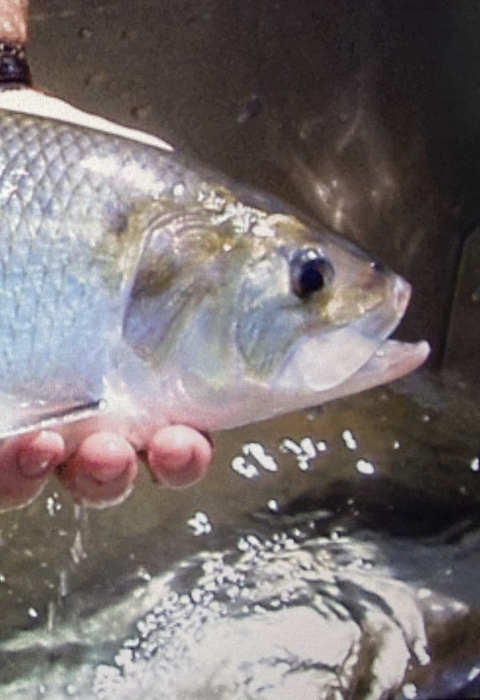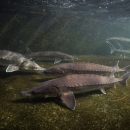There are four hydroelectric dams on the lower Susquehanna River that provide upstream fish passage fish passage
Fish passage is the ability of fish or other aquatic species to move freely throughout their life to find food, reproduce, and complete their natural migration cycles. Millions of barriers to fish passage across the country are fragmenting habitat and leading to species declines. The U.S. Fish and Wildlife Service's National Fish Passage Program is working to reconnect watersheds to benefit both wildlife and people.
Learn more about fish passage . The fish passage facilities are owned and operated by the hydroelectric companies:
- Conowingo Dam (Constellation Energy Corporation)
- Holtwood Dam (Brookfield Renewable U.S.)
- Safe Harbor Dam (Brookfield Renewable U.S.)
- York Haven Dam (York Haven Power Company)
The fish passage facilities are operated in the spring months for the primary purpose of providing upstream passage to American shad, blueback herring and alewife (collectively known as river herring) to reach their spawning grounds in the middle and upper Susquehanna River.
Recently, several invasive fish species have become established in the lower Susquehanna River. Fish passage operations at the dams have been modified to help stop the spread of the invasive northern snakehead and blue catfish upstream into the Susquehanna River and reduce populations of flathead catfish that are already in the Susquehanna. At Conowingo Dam, all fish that are caught in the fish passage facilities are sorted. American shad and river herring are put in a truck and released in spawning habitats upstream of Safe Harbor or York Haven Dams. All invasive fish species are removed and used for research or provided to food shelves. All other fish are returned to the tailrace downstream of Conowingo Dam.
All fish are identified and counted at Conowingo Dam during the spring fish passage season. Preliminary weekly lift counts can be found below:
2024 Fish Counts at Conowingo Dam
| Week Starting | American Shadˆ | Alewifeˆ | Blueback Herringˆ | Northern Snakehead* | Blue Catfish* | Flathead Catfish* | Gizzard Shadˇ | Other Speciesˇ |
| 10 - Mar | 0 | 0 | 0 | 0 | 0 | 66 | 7,483 | 177 |
| 17 - Mar | 0 | 0 | 0 | 0 | 0 | 29 | 18,096 | 237 |
| 24 - Mar | 0 | 0 | 0 | 0 | 0 | 7 | 9,373 | 52 |
| 31 - Mar | 0 | 0 | 0 | 0 | 0 | 3 | 8,511 | 176 |
| 7 - Apr | 0 | 0 | 0 | 0 | 0 | 0 | 4,394 | 621 |
| 14 - Apr | 0 | 0 | 0 | 11 | 1 | 28 | 41,427 | 853 |
| 21 - Apr | 56 | 9 | 0 | 262 | 0 | 7 | 79,048 | 2,067 |
| 28 - Apr | 866 | 7 | 0 | 649 | 0 | 11 | 278,532 | 3,942 |
| 5 - May | 960 | 2 | 37 | 453 | 0 | 1 | 300,482 | 1,721 |
| 12 - May | 72 | 0 | 0 | 115 | 0 | 89 | 238,791 | 1,263 |
| 19 - May | 370 | 1 | 12 | 353 | 3 | 97 | 30,468 | 1,451 |
| Season Totals | 2,324 | 19 | 49 | 1,843 | 4 | 338 | 1,016,605 | 12,560 |
2024 Fish Counts at York Haven Dam
| Week Starting | American Shadˆ | Alewifeˆ | Blueback Herringˆ | Northern Snakehead* | Blue Catfish* | Flathead Catfish* | Other Speciesˇ |
| 0 | 0 | 0 | 0 | 0 | 0 | 0 | |
| Season Totals | 0 | 0 | 0 | 0 | 0 | 0 | 0 |
Annual American Shad Fish Counts
| Year | Conowingo Dam | Holtwood Dam | Safe Harbor Dam | York Haven Dam |
| 1997 | 90,971 | 28,063 | 20,828 | - |
| 1998 | 39,904 | 8,235 | 6,054 | - |
| 1999 | 69,712 | 34,702 | 34,150 | - |
| 2000 | 153,546 | 29,421 | 21,079 | 4,687 |
| 2001 | 193,574 | 109,976 | 89,816 | 16,200 |
| 2002 | 108,001 | 17,522 | 11,705 | 1,555 |
| 2003 | 125,135 | 25,254 | 16,646 | 2,536 |
| 2004 | 109,360 | 3,428 | 2,109 | 219 |
| 2005 | 68,926 | 34,189 | 25,425 | 1,771 |
| 2006 | 56,899 | 35,968 | 24,929 | 1,913 |
| 2007 | 25,464 | 10,338 | 7,215 | 192 |
| 2008 | 19,914 | 2,795 | 1252 | 21 |
| 2009 | 29,272 | 10,896 | 7,994 | 402 |
| 2010 | 37,757 | 16,472 | 12,706 | 907 |
| 2011 | 20,571 | 21 | 8 | - |
| 2012 | 22,143 | 4,238 | 3,089 | 224 |
| 2013 | 12,733 | 2,503 | 1,927 | 202 |
| 2014 | 10,425 | 2,589 | 1,336 | 8 |
| 2015 | 8,341 | 5,286 | 3,690 | 43 |
| 2016 | 14,276 | 6,696 | 4,242 | 178 |
| 2017 | 16,265 | 3,169 | 2,007 | 62 |
| 2018 | 6,992 | 1,458 | 661 | - |
| 2019 | 4,787 | 570 | 316 | - |
| 2020 | 485 | 28 | 1 | - |
| 2021* | 6,825 | - | - | 80 |
| 2022* | 4,597 | - | - | 2 |
| 2023* | 10,021 | - | - | 69 |
*Starting in 2021, all American Shad collected at Conowingo Dam were transported by truck and released upstream of Safe Harbor or York Haven Dams. The fish passage facilities at Holtwood and Safe Harbor Dams have not operated since May 2020.

